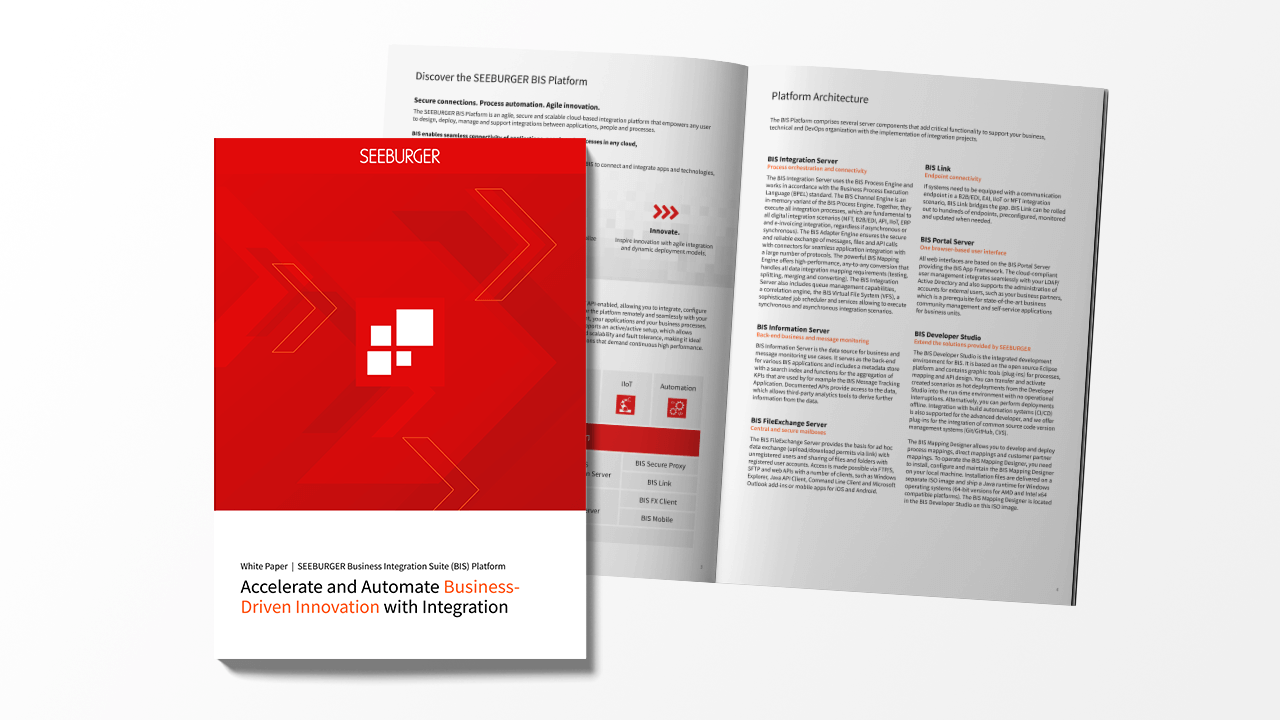
Compare EDI vs. API for B2B Integration
Discover how EDI and APIs blend real-time access and structured data exchange for seamless B2B integration.
1. Executive summary
This Good to Know page discusses the integration of Electronic Data Interchange (EDI) and Application Programming Interfaces (APIs) for B2B systems and trading partners. It highlights EDI's historical role in structured data exchange across industries like automotive, logistics and retail, contrasting it with real-time API capabilities, especially in supply chain processes.
The comparison covers aspects such as transport protocol, call patterns, message formats and business drivers. While EDI focuses on batch processing and long-term partnerships, APIs emphasize real-time interactions and data monetization. Keep reading to learn how both technologies, EDI and API, can complement each other on a single integration platform such as the SEEBURGER BIS Platform.
Electronic Data Interchange (EDI) has played an important role in the integration of external B2B systems and trading partners for decades. Application Programming Interfaces (APIs) provide system functions in real time, which can be accessed and used by other applications. If APIs are designed for it, they can be used to complement B2B integration. Let’s compare EDI vs. API to help you choose the right API and EDI integration approach for your next B2B integration project.
2. EDI vs. API for supply chains
Particularly in supply chain-oriented industries, EDI sets the standard for exchanging information from system to system in an electronic format without the need for paper and manual processes. EDI has been connecting trading partners and automating Supply Chain Management (SCM) since the 1970's. With EDI the data is exchanged in a structured form which, over time, has led to several EDI messaging standards in various industries and regions. EDI continues to dominate supply chain processes for the automotive, logistics, CPG and retail, manufacturing and utilities industries.
EDI uses a file-based or batch communication style with asynchronous calls.
APIs have a long track record as software interfaces to web services and systems. The concept APIs represent today resulted from the Service Oriented Architecture (SOA) movement and the rise of REST and web services over HTTP since the year 2000.
For today’s B2B transactions, APIs are more suitable for real-time business processes and are intended for a more synchronous communication style. Representational state transfer (REST) or RESTful web services provide API interoperability and allow the access and change of textual representations of web resources using a uniform and predefined set of stateless operations.

3. What is the difference between EDI and API?
While the key difference between EDI and API is their history, EDI and API are both integration technologies. The following table provides a comparison of EDI vs. API.
| EDI | APIs | |
|---|---|---|
| History | Established since the 1970s and have grown over time | SOAP available since ~2000, REST raising in Cloud context |
| Transport Protocol | Various protocols including AS2, AS3, OFTP2, SFTP and many more | HTTP/S as underlying transport protocol for API calls |
| Call Pattern | Asynchronous call with acknowledgement messages for structured data | Synchronous call for real-time exchange of structured data |
| Message Format | EDIFACT, ANSI X12 and others based on standardized formats | XML (for e.g. AS4), JSON (for REST) |
| Format Description | Message Guidelines | Open API standard (Swagger), WSDL |
| Directory of Available Formats | Relevant EDI Guideline | API Catalog of API Provider |
| Data Size | Capable of handling mass data | Not intended for mass data |
| Typical Scenarios | Batch-driven processing of bundled information - System-to-System - Data conversion of bundled information - B2B/EDI connection to external trading partners via AS2, OFTP2 or VAN | Information request of modular single requests close to real time - Real-time booking in sequential steps - Enterprise Application Integration (EAI) - Connect to API-enabled cloud applications |
| Content Error Handling | Due to asynchronous batch file processing, this typically takes places in the application (e.g. ERP) that books the received files | Due to the synchronous approach, any error typically stops the API call and error handling takes place at the sender side |
| Standards | Highly standardized with industry-specific flavors | No widespread and established standards |
| Business Drivers | Driven by process optimization and cost reductions in long term business partnerships | Driven by digitalization and monetizing of data, open up new ways of integration, incl. “ad hoc” |
Figure 1: EDI vs. API comparison table
Technically, it is possible to replace well-established EDI B2B integration technologies with APIs. However, every organization must determine the feasability of such a replacement.
Optimal business value comes from choosing the right integration technologies for your B2B use case.
4. EDI and API on one platform
EDI and web service APIs can work together seamlessly and complement each other on one platform. That’s why APIs are often part of a B2B integration strategy, adding real-time access to all sorts of B2B transactions. Real-time (API) and file-based batch (EDI) processes complement each other seamlessly when these processes are running on the same platform and can interact with each other.
The BIS Platform is a cloud-based platform that empowers exactly this type of one-platform approach. BIS offers over 55 different communication adapters, enabling any B2B integration scenario including EDI and API, as well as MFT, IIoT and E-Invoicing.










